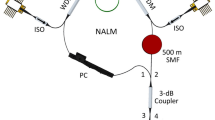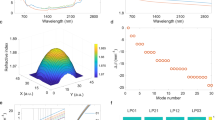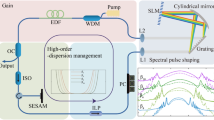Abstract
Saturable absorption in bismuth-doped glasses was found to have a noticeable influence on soliton interaction and group formation. This phenomenon, observed in 1450 nm mode-locked bismuth-doped fiber laser, shows the distinct feature of the multiple pulse regime, which appears as a stationary pulse group whose length can be spread over the whole cavity length by variation of the pump power and polarization. Pulse positioning within the ensemble depends on the saturation fluence and the relatively fast recovery dynamics of bismuth fiber.
Similar content being viewed by others
Introduction
Soliton shaping in a laser cavity is routinely used to produce transform-limited pulses directly from mode-locked oscillators. This pulse shaping strategy can, however, be accompanied by numerous effects that may limit the practical value of the method. The most detrimental consequence associated with the soliton theorem manifests in the form of energy quantization and multiple pulse generation. Though various techniques for energy scaling exploit normal dispersion to avoid soliton pulse shaping1,2,3, high-performance rare-earth erbium and thulium fibers exhibit amplification at the anomalous dispersion regime, making these fibers naturally adapted for soliton operation. Recently, the family of soliton fiber gain media was extended by the invention of non-rare-earth bismuth fibers capable of producing gain in the spectral range from 1.1 to 1.6 µm4,5.
The first bismuth fiber laser was built in 2005 by Dianov et al.6 using bismuth-doped aluminosilicate optical fibers. Later, a variety of high-power continuous-wave7,8, Q-switched, mode-locked and frequency-doubled bismuth fiber lasers has been demonstrated9,10,11. It was found that Bi-doped fiber lasers tend to exhibit reduced efficiency, owing to significant absorption at the lasing wavelength. The nature of this absorption and how it can affect the laser dynamics has not yet been identified. Though the absorption can be partially saturated, some unbleachable loss is always presents in bismuth-doped silica fiber7,12. In this paper we demonstrate that the saturable absorption in Bi-doped fiber plays a critical role in the multiple pulse regime and soliton group formation when operating as a gain medium in a passively mode-locked laser.
Results
The fiber preform was fabricated by the MCVD technique with a bismuth concentration in the fiber core of ≤0.02 at.% and ~5 mol.% of germanium resulting in an index step of Δn = 7 × 10−3. The cut-off wavelength was ~0.9 µm. Absorption and gain spectra obtained for an excitation wavelength of 1320 nm are presented in Fig. 1 (a, b), respectively. The net gain, which peaks at a value of 4.4 dB/m at 1430 nm, is the highest value reported to date for bismuth-doped fiber. The corresponding large value of absorption at 1430 nm could be saturated to a value of 2.8 dB/m by increasing the pump power, as shown in Fig. 1c. The relaxation process of photoluminescence in bismuth-doped fiber frequently exhibits bi-exponential decay13,14. The fast recovery component typically varies from hundreds of nanoseconds to a few microseconds, depending on fiber core composition, while the slow recovery factor was found to be around ~ 700 µs. The pulse dynamics were studied in the mode-locked Bi-doped fiber laser shown in Fig. 2. The gain medium was a 4 m-long bismuth-doped fiber pumped by a 1310 nm disk laser through a 1310/1450 nm pump combiner. Mode-locked operation was achieved utilizing a lens-coupled semiconductor saturable absorber mirror (SESAM) (see details in methods) operated as an end reflector in a linear cavity. The other end of the cavity was terminated by a butt-coupled highly reflective broadband mirror. The passive fiber components of the laser were made of standard telecom single-mode fiber. The total cavity length was 11.5 m, resulting in a fundamental repetition rate of 9 MHz and a net cavity dispersion of 0.22 ps/nm.
The SESAM ensures a self-starting process of mode-locking for pump powers above 140 mW with multiple pulse behavior expected for soliton shaping. The pulse spectrum and autocorrelation shown in Fig. 3 reveal a bandwidth of 5.7 nm with strong Kelly sidebands and a pulse duration of 900 fs for sech2-fitting. The pulse energy of 19.5 pJ corresponds to the fundamental cavity soliton. The time-bandwidth product of 0.73 indicates significant pulse chirping, which originated partly from the long-length output delivery fiber incorporating several spectral filters used for removal of unabsorbed pump radiation. The energy of a single isolated soliton pulse, determined by the dispersion and nonlinearity, is a constant value for a given cavity. The multiple pulse regime therefore sets in for a given level of pump power above the threshold and the extra energy, which cannot be adopted by the fundamental frequency soliton train, is shared among multiple pulse sequences. Single pulse operation could be achieved by reducing the pump power close to the lasing threshold. Though multiple pulsing is a regularly observed behavior for any soliton laser operated with anomalous dispersion, the explicit form of pulse interaction and grouping depends on the cavity details and to date has been studied exclusively for gain materials made of silica glass doped with rare-earth ions. Thus, the observed non-stationary bunches of solitons continuously oscillating within the group were ascribed to the joint action of an attractive force induced by the slowly recovering component of the SESAM and a repulsive soliton-soliton interaction. The specific attribute of such SESAM-induced groups is a small width of ~1 ns or below15,16. Another operating mode is the stationary bunches or bound soliton states, which can develop as a result of direct soliton-soliton interaction. The bound states have a fixed phase difference resulting in a coherent spectral modulation/beating17,18,19. Finally, when the bound and free running solitons coexist in the cavity with a continuous-wave (cw) component, the pulse group could take the form of so-called “soliton rain” due to soliton interaction in a noisy cw background environment20,21. The distinct feature of the “rain” is the regular and steady sliding of the pulse train across the cavity while maintaining the relative positions of the pulses within the group.
A detailed study of the mode-locked laser showed that the recovery dynamics of the bismuth gain medium could essentially affect the soliton interaction and modify significantly the form of steady-state soliton group which was ordinary for rare-earth mode-locked oscillators. In particular, bismuth-doped fibers exhibit large and relatively fast bleachable absorption as compared with rare-earth materials. The formation of a compact soliton group with a temporal length comparable to or less than the bismuth gain recovery time indicates that, compared to an isolated pulse, the group effectively sees a reduced cavity loss. The relatively fast gain/loss recovery in the active medium could change the configuration of the soliton ensemble and soliton distribution within the group, resulting in formation of remarkable stationary states. It can be seen from Fig. 1a, b that bismuth-doped fiber exhibits strong absorption near the lasing wavelength of ~1450 nm dependent on the pump power, while the rate of gain recovery is comparable with the cavity round trip time. The time frame for the soliton group is, therefore, set by the number of pulses within the cavity, the gain recovery and the saturation energy. The compact pulse groups experience reduced losses in a bismuth-doped fiber laser owing to the nearly complete bleaching of the saturable absorption achieved by the joint action of the multiple pulse group. Fig. 4a shows that the group consists of stationary solitons with fixed positions. With increasing pump power, the number of pulses and the group width gradually increase. The temporal size of the group approaches the cavity round trip period and eventually the pulses spread over the whole cavity (Fig. 4a). Fig. 4b (Supplementary video 1) shows a video record of pulse evolution with pump power. The number of soliton pulses within the group and, consequently, the temporal length of the group could be varied by adjustment of the polarization controller. Since the SESAM recombination decay time is much shorter than the pulse separation of a few nanoseconds, it did not assist the pulse group formation and ordering. An inspection of the pulse train, shown in Fig. 4a, reveals the noticeable noisy background present in the cavity. The significant level of noise existing in the cavity could play the role of the cw lasing component that could lead to the formation of a pulse group similar to soliton rain described in20,21.
Oscilloscope picture of soliton group evolution with pump power (a) and corresponding video (Supplementary video 1) (b); c – chirp of pulse separation inside the bunch (Pp = 250 mW).
The pulse separation varies within a group, as seen from Fig. 4c, whereas, the leading edge of the bunch reveals a longer pulse separation than the trailing edge. The entire group represents, however, a stable ensemble without noticeable tendency to disordering or large timing jitter. The non-equidistant, chirpy structure of the group could originate from various effects that produce a repulsive force, pushing the solitons away from each other. In particular, the leading pulses could see a higher gain than the trailing pulses, due to gain depletion. In contrast, the leading pulses could exhibit higher attenuation due to loss saturation, which is notable in the bismuth fiber. The balance of these effects occurs on a timescale of a few tens of nanoseconds, owing to the relatively fast relaxation dynamics of bismuth-doped fiber (< 1 µs) and it determines the steady-state group configuration. Alternatively, the dispersive wave generated by the soliton might collide with the consecutive soliton and, thereby, influence its velocity. A similar effect can be caused by the slowly varying oscillation in the fiber core refractive index generated by the soliton via an acoustic wave. The velocity of the subsequent solitons would be modified depending on the original separation from the exciting pulses22,23.
Conclusion
The gain saturation and bleachable absorption of bismuth fiber induce the distinctive features in soliton interaction and grouping compared with soliton sources based on rare-earth doped fibers15,16. The primary mechanism of group/bunch formation is the reduced loss in bismuth fiber seen by the compact ensemble of solitons that circulates within the laser cavity, as compared with the propagation loss for the same number of individual non-grouped, non-interacting pulses. In particular, the saturation energy and short recovery time of the bismuth gain in silica fiber contribute to soliton organization in the stationary groups/clusters. In contrast, the gain/loss relaxation in rare-earth materials occurring on a much longer time scale cannot contribute to the soliton ordering and result instead in an independent pulse motion along the cavity. Although the start-up and stabilization of passive mode-locking is determined by the characteristics of the semiconductor saturable absorber, the soliton interaction and their relative positioning depend largely on the saturation fluence and recovery dynamics of the bismuth fiber.
Methods
The SESAM structure, grown by RF-plasma-assisted molecular beam epitaxy, comprised 3 Ga0.6In0.4N0.023As0.977/GaAs quantum-wells (QWs) with a thickness of 6 nm. A distributed Bragg reflector (DBR) including 27.5 pairs of ¼-λ thick GaAs/AlAs layers was grown last on top of the gain section. The DBR exhibited a reflectivity of over 99.9% at the pulse wavelength. The QWs were separated by 20-nm-thick GaAs barriers, while the thickness of the spacers was set to place each QW at an antinode of the standing-wave optical field in the microcavity defined by the DBR and the semiconductor-air interface.
The low intensity reflectivity shown in Fig. 5 indicates a spectrally-dependent response of the SESAM with a resonant wavelength around 1430 nm. SESAM saturation energy is estimated to be 25–30 µJ/cm2, the modulation depth at lasing wavelength is 12–14% and the nonsaturable loss is 1–1.5%. The absorption recovery time of the as-grown QWs was controlled by in-situ ion-irradiation with N2+ ions generated by a plasma source24. An ion-irradiation time of two minutes allowed the fast component of the SESAM absorption recovery to be reduced to 2 ps, while the slow component remained at the level of 17 ps.
References
Chong, A., Renninger, W. H. & Wise, F. W. Properties of normal-dispersion femtosecond fiber lasers. JOSA B 25, 140–148 (2008).
Lecaplain, C., Baumgartl, M., Schreiber, T. & Hideur, A. On the mode-locking mechanism of a dissipative-soliton fiber oscillator. Opt. Exp. 19, 26742–26751 (2011).
Ouyang, C. et al. Pulse-shaping dynamics controlled by four structural paramters in an all-normal-dispersion mode-locked fiber laser. JOSA B 26, 1875–1881 (2009).
Bufetov, I. A. & Dianov, E. M. Bi-doped fiber lasers. Laser. Phys. Lett. 6, 487–504 (2009).
Dianov, E. M. Bi-doped glass opticsl fibers: Is it a new brekthrough in laser materials? J. Non-Cryst. Solids 355, 1861–1864 (2009).
Dianov, E. M. et al. CW bismuth fibre laser. Quantum. Electron. 35, 1083–1084 (2005).
Dianov, E. M., Shubin, A. V., Melkumov, M. A., Medvedkov, O. I. & Bufetov, I. A. High-power cw bismuth-fiber lasers. JOSA B 24, 1749–1755 (2007).
Razdobreev, I. et al. Efficient all-fiber bismuth-doped laser. Appl. Phys. Lett. 90, 031103 (2007).
Dvoyrin, V. V., Mashinsky, V. M. & Dianov, E. M. Yb-Bi pulsed fiber lasers. Opt. Lett. 32, 451–453 (2007).
Dianov, E. M. et al. Mode-locked Bi-doped fiber laser. JOSA B 24, 1807–1808 (2004).
Kivistö, S. et al. Mode-locked Bi-doped all-fiber laser with chirped fiber Bragg grating. IEEE Phot. Tech. Lett. 21, 599–601 (2009).
Kalita, M. P., Yoo, S. & Sahu, J. Bismuth doped fiber laser and study of unsaturable loss and pump induced absorption in laser performance. Opt. Exp. 16, 21032–21038 (2008).
Razdobreev, I. & Bigot, L. On the multiplicity of Bismuth active centers in germano-aluminosilicate perform. Opt. Mater. 33, 973–977 (2011).
Razdobreev, I. et al. Optical spectroscopy of bismuth-doped pure silica fiber perform. Opt. Lett. 35, 1341–1343 (2010).
Gumenyuk, R. & Okhotnikov, O. G. Temporal control of vector soliton bunching by slow/fast saturable absorption. JOSA B 29, 1–7 (2012).
Gumenyuk, R., Gaponenko, M. S., Yumashev, K. V., Onuschenko, A. A. & Okhotnikov, O. G. Vector soliton bunching in thulium-holmium fiber laser mode-locked with PbS quantum-dot-doped glass absorber. IEEE J. Quant. Electron. 48, 903–907 (2012).
Ortaç, B. et al. Generation of bound states of three ultrashort pulses with a passively mode-locking high-power Yb-doped double-clad fiber laser. IEEE Phot. Tech. Lett. 16, 1274–1276 (2004).
Tang, D. Y., Zhao, B., Shen, D. Y. & Lu, C. Bound-soliton fiber laser. Phys. Rev. A 66, 033806 (2002).
Grelu, Ph. & Soto-Crespo, J. M. Multisoliton states and pulse fragmentation in passively mode-locked fibre laser. J. Opt. B-Quantum S. O. 6, S271–S278 (2004).
Chouli, S. & Grelu, P. Rains of solitons in a fiber laser. Opt. Exp. 17, 11776–11781 (2009).
Chouli, S. & Grelu, P. Soliton rains in a fiber laser: An experimental study. Phys. Rev. A 81, 063829 (2010).
Pilipetskii, A., Golovchenko, E. A. & Menyuk, C. R. Acoustic effect in passively mode-locked fiber ring lasers. Opt. Lett. 20, 907–909 (1995).
Smith, K., & Mollenauer, L. F. Experimental observation of soliton interaction over long fiber paths: discovery of a long range interaction. Opt. Lett. 14, 1284–1286 (1989).
Guina, M. et al. Semiconductor saturable absorbers with recovery time controlled through growth conditions. Photonics West SPIE Proc. 6451, 645113 (2007).
Acknowledgements
The authors would like to thank Janne Puustinen, Jari Lyytkäinen and Mircea Guina from Reflekron Oy for help with MBE growth. This work was supported by EU project PIRSES-GA-2010-269271.
Author information
Authors and Affiliations
Contributions
R.G. and O.G.O. designed the experiments and analyzed the data; R.G. made the laser measurements; V.F.K. designed and made the Bi-doped fiber preform; M.A.M. and E.M.D. prepared the samples of Bi-doped fiber and characterized them; R.G., O.G.O. and M.A.M. wrote the manuscript, all authors reviewed the manuscript.
Ethics declarations
Competing interests
The authors declare no competing financial interests.
Electronic supplementary material
Supplementary Information
Supplementary information
Supplementary Information
Supplementary video 1
Rights and permissions
This work is licensed under a Creative Commons Attribution-NonCommercial-ShareAlike 4.0 International License. The images or other third party material in this article are included in the article's Creative Commons license, unless indicated otherwise in the credit line; if the material is not included under the Creative Commons license, users will need to obtain permission from the license holder in order to reproduce the material. To view a copy of this license, visit http://creativecommons.org/licenses/by-nc-sa/4.0/
About this article
Cite this article
Gumenyuk, R., Melkumov, M., Khopin, V. et al. Effect of absorption recovery in bismuth-doped silica glass at 1450 nm on soliton grouping in fiber laser. Sci Rep 4, 7044 (2014). https://doi.org/10.1038/srep07044
Received:
Accepted:
Published:
DOI: https://doi.org/10.1038/srep07044
This article is cited by
-
Dual-wavelength all-fiber Q-switched fiber laser using bismuth-doped fiber as saturable absorber
Optoelectronics Letters (2024)
-
Infiltrated bunch of solitons in Bi-doped frequency-shifted feedback fibre laser operated at 1450 nm
Scientific Reports (2017)
-
1700 nm dispersion managed mode-locked bismuth fiber laser
Scientific Reports (2016)
-
A 23-dB bismuth-doped optical fiber amplifier for a 1700-nm band
Scientific Reports (2016)
Comments
By submitting a comment you agree to abide by our Terms and Community Guidelines. If you find something abusive or that does not comply with our terms or guidelines please flag it as inappropriate.








